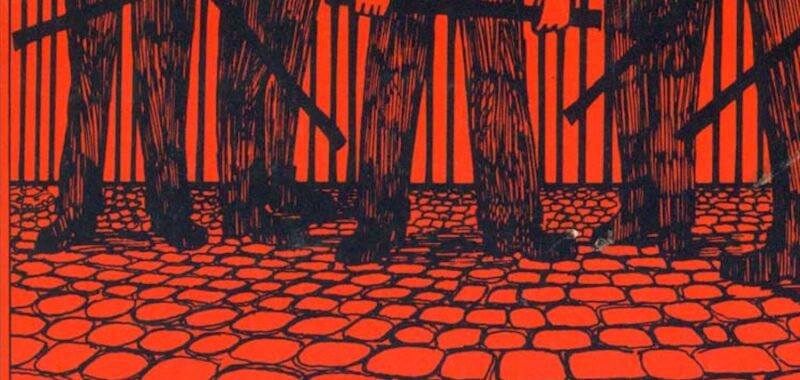In one of the most prescient dystopian works ever written, the narrator describes how the party in government, having lost an election, declined to leave office. “The incumbents refused to get out. It was very simple. They merely charged illegality in the elections and wrapped up the whole situation in the interminable red tape of the law. The Democrats were powerless. The courts were in the hands of their enemies.”
Article continues after advertisement
Okay, in quoting that passage, I cheated. I changed the fictional “Grangers” to the real-world “Democrats.” But let’s admit that Jack London’s The Iron Heel, published in 1908, shows uncanny foresight in anticipating the end game of the 2020 election, when MAGA Republicans fought tooth and nail to retain control of the White House.
London knew the ruling class was tough and would hit back because he himself was tough.
Readers who know Jack London only as the author of the classic animal stories The Call of the Wild and White Fang will be surprised by the political engagement of The Iron Heel. Published almost three decades before Sinclair Lewis’s It Can’t Happen Here, this was the first American novel to warn against the rise of fascism and the emergence of a right-wing dictatorship in the United States. In The Iron Heel, London refers repeatedly to “the people of the abyss.” He had already used that expression as the title of a non-fiction book—one that influenced Orwell to write Down and Out in Paris and London. But in this book, London offers a footnote saying that he took his title from a phrase “struck out of the genius of H.G. Wells.”
While harking back to Wells, London’s dystopian novel also looks forward. It anticipates Orwell, who himself described Iron Heel as “a very remarkable prophecy of the rise of Fascism.” Orwell also asserted that London was a better prophet “than many better-informed and more logical thinkers.” He could foresee the cruel struggles that lay ahead “because of the streak of brutality which he had in himself.” London knew the ruling class was tough and would hit back because he himself was tough. The best of London’s stories, Orwell wrote, “deal with prison, the prize-ring, the sea, and the frozen wastes of Canada—that is, with situations where toughness is everything.”
In The Iron Heel, London uses a futuristic framing device now familiar from later dystopian novels, such as Nineteen Eighty-Four and The Handmaid’s Tale. In this case, a scholar by the name of Anthony Meredith, writing from the vantage point of around 2600 CE, supplies a short foreword introducing an ancient manuscript (early twentieth century)—a long-lost memoir by Avis Everhard. Throughout, Meredith adds the occasional footnote to clarify allusions and correct errors.
The story covers the period from 1912 to 1932 and treats the evolution of the powerful “Oligarchs” in the US into the ruling dictatorship of the Iron Heel. The Oligarchy comprises a few massive and growing “trusts” run by individuals who have become obscenely rich and powerful by squeezing small and middle-sized businesses into capitulation. The contemporary reader cannot help but think of the top 1 percent of Americans, billionaires said to control 40 percent of the nation’s wealth—though some say that figure is much higher.
Jack London drew heavily on the theories of Karl Marx, who had argued that capitalism is unsustainable and would destroy itself. In 1937, the Marxist revolutionary Leon Trotsky would write of The Iron Heel that “London already foresaw and described the fascist regime as the inevitable result of the defeat of the proletarian revolution.” By then, of course, fascists were in the ascendant—not in the US, but in Spain, Italy, Germany, and even France. Those in France during the Second World War who opposed the fascists, and instead championed the people of the abyss, would comprise the French Resistance.
It remains possible that London’s three-century scenario…will prove more eerily prescient than anyone could have imagined.
On one level, London’s narrative becomes a journey of discovery for Avis as she investigates her lover’s highly articulate contention that the existing social order is built on the exploitation of labour. She sees her father, a prominent physician, who because of his outspoken opposition, his resistance, has lost his medical practice and faces financial hardship. She sees a family friend, a reformed priest, driven into a mental asylum for challenging the Oligarchy. She opens her eyes to the “people of the abyss”—and to what they are up against.
While Avis writes in the belief that she and her fellow revolutionaries will succeed in overthrowing the Iron Heel, the latecomer Anthony Meredith reveals that their revolution will end in failure. But London lays out a scenario in which such setbacks are to be expected: the class revolution fails repeatedly until the 2200s. It remains possible that London’s three-century scenario, as outlined by Anthony Meredith, will prove more eerily prescient than anyone could have imagined.
That is because The Iron Heel anticipates Trumpism and its unwillingness to concede defeat. As Orwell observed, Jack London foresaw that “when the working-class movements took on formidable dimensions and looked like dominating the world, the capitalist class would hit back. They wouldn’t simply lie down and let themselves be expropriated, as so many socialists had imagined.” London’s main achievement, he wrote, was to foresee “that the menaced capitalist class would counterattack and not quietly die because the writers of Marxist textbooks told it to die.” Neither London nor Orwell would be surprised to see Donald Trump and far-right Republicans manning the barricades for the billionaire class.
__________________________________

From Shadows of Tyranny: Defending Democracy in an Age of Dictatorship by Ken McGoogan. Copyright © 2024. Available from Douglas & McIntyre.

